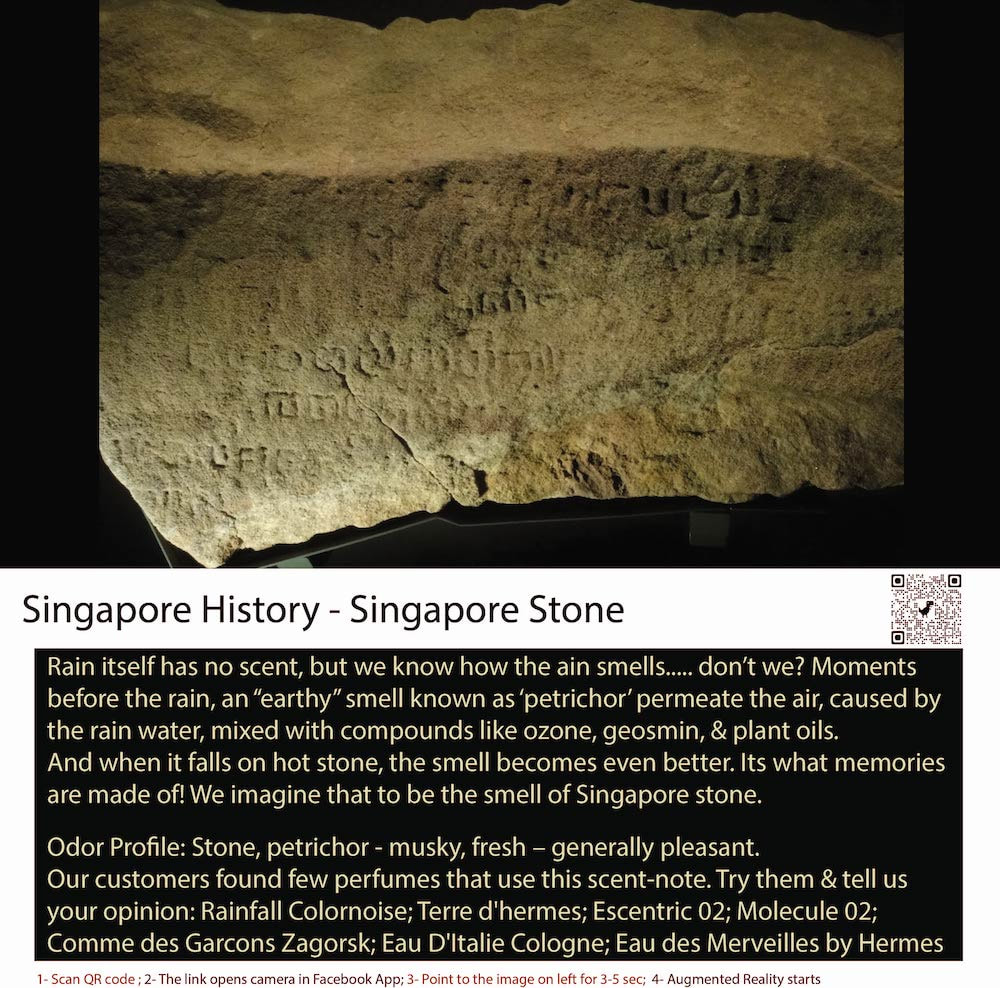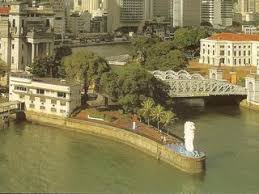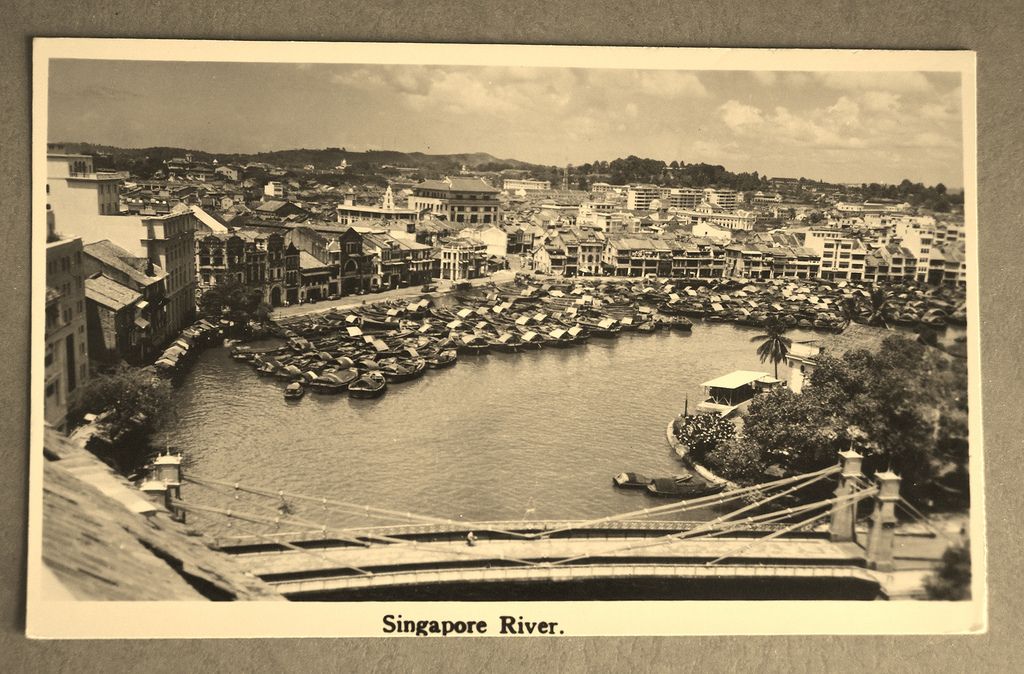Experience the Essence of Rain-Kissed Singapore
The Singapore Stone is an ancient sandstone slab that holds significant historical and archaeological value. It was discovered in the early 19th century on the banks of the Singapore River, near the mouth of the Singapore Strait. The stone is inscribed with mysterious ancient script that has intrigued scholars and historians for centuries, making it one of Singapore's most enigmatic and enduring artifacts.
The Singapore Stone measures about 3 meters in length, 1.2 meters in width, and 0.2 meters in thickness. The inscriptions on the stone are written in an ancient script known as Kawi, which was commonly used in ancient Southeast Asia. However, the script on the stone remains undeciphered, and its meaning and purpose remain a subject of debate and speculation among researchers.
One of the earliest recorded accounts of the Singapore Stone dates back to 1819, when Sir Stamford Raffles, the founder of modern Singapore, learned about the existence of the stone from local inhabitants. At that time, the stone was partially buried in the ground, and only a small portion of it was visible. Raffles ordered the stone to be moved to the compound of his residence in Singapore, where it was reassembled and placed as a decorative feature.
Over the years, the Singapore Stone was moved several times, and it now resides at the National Museum of Singapore, where it is displayed as a significant artifact of the nation's history.
The inscriptions on the Singapore Stone have been a subject of great interest and fascination for scholars, archaeologists, and historians. Various theories have been proposed regarding the origin and meaning of the script. Some believe that it could be a memorial stone or an ancient boundary marker, while others speculate that it may have religious or ceremonial significance.
Despite extensive research and study, the script on the Singapore Stone remains undeciphered to this day. The lack of a bilingual inscription or known key text has posed challenges in understanding the language and context of the inscriptions. As a result, the stone continues to be a puzzle that has eluded conclusive interpretation.
Beyond its historical significance, the Singapore Stone has also become a symbol of national identity and pride for the people of Singapore. It represents the rich cultural and historical heritage of the island nation, reminding its citizens of the deep-rooted past that has shaped the present-day Singapore.
In recent years, efforts have been made to promote the significance of the Singapore Stone and increase public awareness about its historical importance. Museums and educational institutions in Singapore often feature the stone in exhibitions and educational programs to engage the public in its story and mysteries.
In conclusion, the Singapore Stone is an ancient sandstone slab that holds great historical and archaeological value. Despite its discovery over two centuries ago, the inscriptions on the stone remain undeciphered, sparking intrigue and debate among scholars. As a symbol of Singapore's rich heritage, the stone stands as a testament to the island nation's ancient past and continues to captivate the imagination of those who encounter it.
The Singapore Stone measures about 3 meters in length, 1.2 meters in width, and 0.2 meters in thickness. The inscriptions on the stone are written in an ancient script known as Kawi, which was commonly used in ancient Southeast Asia. However, the script on the stone remains undeciphered, and its meaning and purpose remain a subject of debate and speculation among researchers.
One of the earliest recorded accounts of the Singapore Stone dates back to 1819, when Sir Stamford Raffles, the founder of modern Singapore, learned about the existence of the stone from local inhabitants. At that time, the stone was partially buried in the ground, and only a small portion of it was visible. Raffles ordered the stone to be moved to the compound of his residence in Singapore, where it was reassembled and placed as a decorative feature.
Over the years, the Singapore Stone was moved several times, and it now resides at the National Museum of Singapore, where it is displayed as a significant artifact of the nation's history.
The inscriptions on the Singapore Stone have been a subject of great interest and fascination for scholars, archaeologists, and historians. Various theories have been proposed regarding the origin and meaning of the script. Some believe that it could be a memorial stone or an ancient boundary marker, while others speculate that it may have religious or ceremonial significance.
Despite extensive research and study, the script on the Singapore Stone remains undeciphered to this day. The lack of a bilingual inscription or known key text has posed challenges in understanding the language and context of the inscriptions. As a result, the stone continues to be a puzzle that has eluded conclusive interpretation.
Beyond its historical significance, the Singapore Stone has also become a symbol of national identity and pride for the people of Singapore. It represents the rich cultural and historical heritage of the island nation, reminding its citizens of the deep-rooted past that has shaped the present-day Singapore.
In recent years, efforts have been made to promote the significance of the Singapore Stone and increase public awareness about its historical importance. Museums and educational institutions in Singapore often feature the stone in exhibitions and educational programs to engage the public in its story and mysteries.
In conclusion, the Singapore Stone is an ancient sandstone slab that holds great historical and archaeological value. Despite its discovery over two centuries ago, the inscriptions on the stone remain undeciphered, sparking intrigue and debate among scholars. As a symbol of Singapore's rich heritage, the stone stands as a testament to the island nation's ancient past and continues to captivate the imagination of those who encounter it.
To experience augmented reality, please open the Facebook-app using QR code and point to the image below
Unveiling the Natural Aromas of Singaporean Rain
The first and perhaps most important exhibit in National museum is the Singapore Stone. It is a fragment of a large sandstone slab which originally stood at the mouth of the Singapore River, today's Fullerton Hotel. The slab is believed to date back to at least the 13th century and possibly as early as the 10th or 11th century, bore an undeciphered inscription.
Since Singapore was believed to be governed under Majapahit's rule, the inscription could be Old Javanese or Sanskrit.
The Singapore stone is a fragment of a large sandstone slab that was discovered in Singapore in the 19th century. The slab is believed to have been part of an ancient writing system, possibly from the 14th century. The stone was inscribed with an unknown script, which has been variously referred to as Old Javanese, Kawi, or "ancient Malay".
The Singapore stone was discovered in 1843 by a British engineer named John Turnbull Thomson, who was working on the construction of the Singapore-Malaysia railway. The stone was originally located at the mouth of the Singapore River, but it was later moved to the British Museum in London.
The Singapore stone is an important artifact in the history of Singapore, as it represents one of the earliest examples of written records in the region. The script on the stone has never been deciphered and its origin and meaning remains a mystery.
The Singapore stone is also a symbol of national pride and cultural heritage, and it has been featured on the coat of arms of the National Museum of Singapore.
Since Singapore was believed to be governed under Majapahit's rule, the inscription could be Old Javanese or Sanskrit.
The Singapore stone is a fragment of a large sandstone slab that was discovered in Singapore in the 19th century. The slab is believed to have been part of an ancient writing system, possibly from the 14th century. The stone was inscribed with an unknown script, which has been variously referred to as Old Javanese, Kawi, or "ancient Malay".
The Singapore stone was discovered in 1843 by a British engineer named John Turnbull Thomson, who was working on the construction of the Singapore-Malaysia railway. The stone was originally located at the mouth of the Singapore River, but it was later moved to the British Museum in London.
The Singapore stone is an important artifact in the history of Singapore, as it represents one of the earliest examples of written records in the region. The script on the stone has never been deciphered and its origin and meaning remains a mystery.
The Singapore stone is also a symbol of national pride and cultural heritage, and it has been featured on the coat of arms of the National Museum of Singapore.
Crafted with Care: The Science of Our Stone-inspired Scents
The slab is linked to the legendary story of the 14th-century strongman Badang, who is said to have thrown a massive stone to the mouth of the Singapore River. On Badang's death, the Rajah sent two stone pillars to be raised over his grave "at the point of the straits of Singapura".
Badang, also known as "Badang the Strongman," is a legendary figure in the history of Singapore. He is said to have been a powerful and skilled warrior who lived in the early 19th century. According to legend, Badang was able to lift and throw large boulders, and he was able to perform other impressive feats of strength.
One famous story about Badang is that he used the Singapore Stone, a large sandstone slab that was discovered in Singapore in the 19th century, as a weight to perform his feats of strength. According to the legend, Badang was able to lift the Singapore Stone and throw it into the sea. The stone was said to be so heavy that no one else could move it.
However, it is important to note that the story of Badang and his association with the Singapore Stone is purely legendary and not based on any historical evidence. The Singapore stone is known as an ancient artifact and was discovered in 1843 by a British engineer named John Turnbull Thomson. It was inscribed with an unknown script and its origin and meaning remains a mystery.
The story of Badang is considered an important part of the folklore and mythology of Singapore, and it is still told and remembered today as a representation of strength and power.
Badang, also known as "Badang the Strongman," is a legendary figure in the history of Singapore. He is said to have been a powerful and skilled warrior who lived in the early 19th century. According to legend, Badang was able to lift and throw large boulders, and he was able to perform other impressive feats of strength.
One famous story about Badang is that he used the Singapore Stone, a large sandstone slab that was discovered in Singapore in the 19th century, as a weight to perform his feats of strength. According to the legend, Badang was able to lift the Singapore Stone and throw it into the sea. The stone was said to be so heavy that no one else could move it.
However, it is important to note that the story of Badang and his association with the Singapore Stone is purely legendary and not based on any historical evidence. The Singapore stone is known as an ancient artifact and was discovered in 1843 by a British engineer named John Turnbull Thomson. It was inscribed with an unknown script and its origin and meaning remains a mystery.
The story of Badang is considered an important part of the folklore and mythology of Singapore, and it is still told and remembered today as a representation of strength and power.
Elevate Your Senses with Scentopia's Aromatherapy Products
Badang's story
Badang was a young slave who dreamed of becoming strong and free. One day, Bandang discovered only bones in his fishing net instead of fishes. Determined to catch the culprit, Badang cast his net again and hid to catch the thief. The thief turned out to be a strange looking spectre. Badang fearlessly confronted the spectre and won. Hence, Badang was granted a wish and he wished to be the strongest man on the planet.
Soon, the King of ancient Singapore, Sri Rama Wira Kerma, heard about Badang's strength and summoned him to his court, appointing him as a court warrior. Badang's fame went beyond to as far as India. Not to be outdone, the ruler of India sent the kingdom's strongest man, Wadi Bijaya, to Singapura for a duel with Badang.
During these tests Badang turned out to be the stronger of the two. The final test of the series was to throw a rock. While Wadi Bijaya could only lift the enormous rock up to his knees, Badang lifted it up over his head and flung it into the sea where it landed near the mouth of Sungai Singapura (Singapore River).
This is the story of Badang and Singapore Stone.
Badang was a young slave who dreamed of becoming strong and free. One day, Bandang discovered only bones in his fishing net instead of fishes. Determined to catch the culprit, Badang cast his net again and hid to catch the thief. The thief turned out to be a strange looking spectre. Badang fearlessly confronted the spectre and won. Hence, Badang was granted a wish and he wished to be the strongest man on the planet.
Soon, the King of ancient Singapore, Sri Rama Wira Kerma, heard about Badang's strength and summoned him to his court, appointing him as a court warrior. Badang's fame went beyond to as far as India. Not to be outdone, the ruler of India sent the kingdom's strongest man, Wadi Bijaya, to Singapura for a duel with Badang.
During these tests Badang turned out to be the stronger of the two. The final test of the series was to throw a rock. While Wadi Bijaya could only lift the enormous rock up to his knees, Badang lifted it up over his head and flung it into the sea where it landed near the mouth of Sungai Singapura (Singapore River).
This is the story of Badang and Singapore Stone.
The stone slab was lost to time. It was re-found in June 1819, a few months after the arrival of Sir Stamford Raffles in Singapore. Few laborer clearing the jungle near Singapore river came across a sandstone slab about 10 ft (3.0 m) high and 9 to 10 ft (2.7 to 3.0 m). It stood at a promontory known as the Rocky Point. This same place has had many names since then - Artillery Point, Fort Fullerton and the Master Attendant's Office. Today it is a heritage hotel.
In 1972, a slab was constructed at this spot and a statue of Merlion was placed on it.
In 1972, a slab was constructed at this spot and a statue of Merlion was placed on it.
Natural Rain-Inspired Fragrance
About January 1843, the slab was blown widen the passageway at the Singapore River mouth to make space for Fort Fullerton. Lieutenant-Colonel James Low had petitioned to have the sandstone slab spared, but was not successful. When the explosion took place, he crossed the river and selected fragments that had letters on them. As the fragments were very bulky, he had them chiselled into small slabs by a Chinese man.
He selected some of the smaller fragments bearing the most legible parts of the inscription and sent them to the Royal Asiatic Society's museum in Calcutta (now known as the Indian Museum) for analysis, where they arrived in about June 1848.
It has been given on permanent loan to National Museum of Singapore by Calcutta museum. There may be few more pieces in Calcutta museum, but so far no one has been able to identify them.
He selected some of the smaller fragments bearing the most legible parts of the inscription and sent them to the Royal Asiatic Society's museum in Calcutta (now known as the Indian Museum) for analysis, where they arrived in about June 1848.
It has been given on permanent loan to National Museum of Singapore by Calcutta museum. There may be few more pieces in Calcutta museum, but so far no one has been able to identify them.
Explore the Scentopia Difference: Quality and Sustainability
Smell of stone has been captured by Indian perfumers and its called "Mitti Attar".
Mitti Attar, also known as "earth attar" or "soil attar," is a type of natural perfume oil Homethat is extracted from the soil of certain regions. The process of making Mitti Attar involves collecting soil from specific locations, heating it in a distillation process, and collecting the resulting steam, which contains the essential oils of the soil. These oils are then blended together to create the final product.
The aroma of Mitti Attar is typically described as earthy, woody, and musky, with hints of damp soil, clay, and moss. It is considered to be a grounding and grounding scent that is said to evoke feelings of connection to the earth and nature.
Mitti Attar is traditionally used in Ayurvedic and traditional Indian medicine as a remedy for various ailments, including respiratory problems, skin issues, and stress. It is also used in perfumery, as well as in incense and other ritualistic and spiritual practices.
It is not commonly used in perfumery, it is more used in traditional medicine and spiritual practices. It is considered to be a unique and exotic scent that is not easy to find and is considered to be very rare. It is also considered to be very expensive due to its difficult extraction process and the rarity of the soil used.
Mitti Attar, also known as "earth attar" or "soil attar," is a type of natural perfume oil that is extracted from the soil of certain regions. It is used in aromatherapy to create a grounding and soothing experience.
In aromatherapy, the earthy, woody, and musky aroma of Mitti Attar is said to evoke feelings of connection to nature and the earth. It is believed to have a calming and grounding effect on the mind and body, helping to reduce stress and anxiety. Some people also use it to promote feelings of inner peace and tranquility.
Mitti Attar is also believed to have therapeutic properties for respiratory issues, skin problems, and other ailments. It is often used in aromatherapy massage and other bodywork practices to promote physical and emotional well-being.
It can be used in diffusers, as a massage oil, or in a bath to experience its benefits. It is also often used in meditation and yoga practices to enhance the grounding and calming effects.
It is important to note that Mitti Attar is a rare and expensive oil, and it is not commonly used in aromatherapy. It is also important to make sure that you purchase the oil from a reputable source, as there are many synthetic or adulterated versions of the oil available in the market.
Perfume making typically relies on natural ingredients such as flowers, fruits, woods, and spices, and it is less common to find earthy or mineral-based scents like "Mitti Attar" or "stone" in commercial perfumes. They are considered to be unusual, rare and difficult to be found in the market.
That being said, there are a few perfumes that incorporate earthy or soil-like notes in their scent profile. These scents are typically described as "mossy," "forest floor," "humus," "vegetal" or "woody" . They tend to be found in perfumes that have a natural or earthy aesthetic. They can be found in some niche perfumery brands or artisanal perfumers.
Some examples of perfumes that have an earthy or soil-like scent note are:
Mitti Attar, also known as "earth attar" or "soil attar," is a type of natural perfume oil Homethat is extracted from the soil of certain regions. The process of making Mitti Attar involves collecting soil from specific locations, heating it in a distillation process, and collecting the resulting steam, which contains the essential oils of the soil. These oils are then blended together to create the final product.
The aroma of Mitti Attar is typically described as earthy, woody, and musky, with hints of damp soil, clay, and moss. It is considered to be a grounding and grounding scent that is said to evoke feelings of connection to the earth and nature.
Mitti Attar is traditionally used in Ayurvedic and traditional Indian medicine as a remedy for various ailments, including respiratory problems, skin issues, and stress. It is also used in perfumery, as well as in incense and other ritualistic and spiritual practices.
It is not commonly used in perfumery, it is more used in traditional medicine and spiritual practices. It is considered to be a unique and exotic scent that is not easy to find and is considered to be very rare. It is also considered to be very expensive due to its difficult extraction process and the rarity of the soil used.
Mitti Attar, also known as "earth attar" or "soil attar," is a type of natural perfume oil that is extracted from the soil of certain regions. It is used in aromatherapy to create a grounding and soothing experience.
In aromatherapy, the earthy, woody, and musky aroma of Mitti Attar is said to evoke feelings of connection to nature and the earth. It is believed to have a calming and grounding effect on the mind and body, helping to reduce stress and anxiety. Some people also use it to promote feelings of inner peace and tranquility.
Mitti Attar is also believed to have therapeutic properties for respiratory issues, skin problems, and other ailments. It is often used in aromatherapy massage and other bodywork practices to promote physical and emotional well-being.
It can be used in diffusers, as a massage oil, or in a bath to experience its benefits. It is also often used in meditation and yoga practices to enhance the grounding and calming effects.
It is important to note that Mitti Attar is a rare and expensive oil, and it is not commonly used in aromatherapy. It is also important to make sure that you purchase the oil from a reputable source, as there are many synthetic or adulterated versions of the oil available in the market.
Perfume making typically relies on natural ingredients such as flowers, fruits, woods, and spices, and it is less common to find earthy or mineral-based scents like "Mitti Attar" or "stone" in commercial perfumes. They are considered to be unusual, rare and difficult to be found in the market.
That being said, there are a few perfumes that incorporate earthy or soil-like notes in their scent profile. These scents are typically described as "mossy," "forest floor," "humus," "vegetal" or "woody" . They tend to be found in perfumes that have a natural or earthy aesthetic. They can be found in some niche perfumery brands or artisanal perfumers.
Some examples of perfumes that have an earthy or soil-like scent note are:
- "Mousse de Saxe" by Parfumerie Generale
- "Terra" by Bvlgari
- "Dirt" by Demeter Fragrance Library
Join Scentopia, Sentosa's latest tourist attraction wonderful orchid scent crafting, fragrance tour, bridal shower or corporate team building which includes perfume making onsite and offsite, beach activities and more. We also serve primary school learning journey, secondary students and pupil on industrial excursions. Know more about our orchids perfume bar or therapeutic orchid scents and other wellness aromas. Conatct Perfume workshop or book a scent crafting session here.






